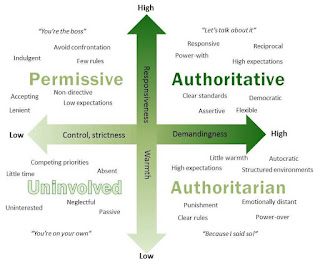What to Do When Gates Aren't Enough -- Safe Spaces for Toddlers (and Preschoolers)
I hear from parents all the time who are frustrated because their young children are getting into everything and don't listen to "no". The parents are frustrated and often have resorted to some kind of punishment or consequences because their old methods aren't working anymore. Is this you? Then read on.
First, let’s define some terms to make sure we’re on common ground:
I talk a lot about limits and boundaries and to me, the two are different. Limits are the things we don’t let our kids do because they’re inappropriate, unkind, or unsafe, or unhealthy for them or others. Boundaries are things we don’t let our kids do because it’s not okay with us, personally. Boundaries also define what we have a right to control and what we don’t. So an example of a limit is, “I won’t let you run into the street. When we cross, we will go together, holding hands.” An example of a boundary is, “I don’t want you to climb here. I’m afraid this could get broken.” You would enforce both, but it’s important to differentiate between things that are absolutely non-negotiable safety issues, and those that are a matter of personal preference. Having healthy boundaries also means asking yourself, “Does this impact me, or my child’s safety, or is this just something I think they should do or not do?” Personal preferences and needs (boundaries) are important, and we can stand for these just as much as we stand for our children’s and others’ physical safety by setting limits.
It’s also important to define authoritative parenting. An authoritative approach, characterized by high warmth (responsiveness) and high expectations (demand), has been associated with many positive short-term and long-term outcomes, compared to authoritarian or permissive approaches. My experience has been that authoritarian and permissive approaches are at opposite ends of the spectrum when it comes to setting limits, with an authoritative approach falling right in the middle, but what really differentiates authoritative parenting from the other two is healthy boundaries, which authoritarian and permissive approaches both lack. Healthy boundaries determine what is appropriate to limit and what is not. Authoritarian parents attempt to control too much of their children’s lives and experience (parent overruns the child), while permissive parents tend not to set appropriate limits when they should (child overruns the parent, and often everyone else too).
Another important concept is a “yes-space” or “safe space”. Magda Gerber defined a safe space as one where, if the parent were to accidentally be locked out of the house without keys, by the time the parent managed to get back inside, the child would be, at worst, hungry and wet, but unharmed. This applies for infants, toddlers, and even preschoolers—any age at all until the child is old enough to be safe in the home for a brief period without an adult in the immediate area (usually up to around age 5 to 7, depending on the maturity of the child). The space will need to change and grow with the child, and as they get older, there will be times when they will be able to play outside the space with decreasing attention from the caregiver, but the space is still maintained for the times when the caregiver determines that the boundary is needed. The greatest benefit of this space is it intentionally reduces the limits you need to set, which reserves some social capital between you and your child for those times when their cooperation is more important, and it also frees you up to focus on more than just following your child around the house all day to keep them from getting into everything!
"Setting limits" or establishing boundaries does not always mean using words. In general, but especially with young kids, many boundaries are enforced physically and environmentally. For example, the doors and walls of your house are an environmental boundary that keep your children from running into the street. Hopefully you keep poisons locked away, knives put up, and gates (affiliate link) used wisely to establish the boundaries of your child’s safe space—those are also environmental boundaries. When boundaries in the home are not well-defined, many parents turn to punishment or consequences to enforce expectations. The problem with this is it pits parents against children, which erodes connection.
In my experience, the best way to make punishment a relative non-issue is to preempt problems by establishing and enforcing clear boundaries *before* children do something they shouldn't. By being proactive instead of reactive. This means child-proofing, it means watching the kids if they're in a space that's not fully intended for them, and it means being aware of their mood and predicting their behavior to prevent problems. What are some ways you can modify your children’s environment to support the limits you set?
So what to do when the gates aren’t enough?
Some limits also need to be enforced or reinforced physically, often by stating the limit and removing or blocking the child from the unacceptable location or action. When the environment is set up to prevent problems, but your child seems unfazed by the boundaries you have in place, then it means you need to get involved in different ways. It's hard to say why gates don't work well for some people without seeing the whole picture, because there are so many factors, including parenting styles, as I mentioned above.
So when the gates (and this applies to cribs too!) aren’t enough on their own (which for some people happens as early as 15-18 months), there are a few things you can do:
Be More Authoritative
As you can guess, authoritative parenting has the most positive results overall, so parents who identify their style as more authoritarian or more permissive, and are struggling with children getting into things they shouldn’t, will benefit from shifting their approach to be more authoritative and assertive. You let the environmental boundaries do most of the work, but when your kids push/test those boundaries, you reinforce them verbally and with your own physical presence as well. For example, "Gates are not for climbing. I'm going to help you get down."
Being more authoritative will help if the child is testing or checking to see if your limits will be enforced consistently. This kind of testing is more common when parents/caregivers first shift from a punitive or permissive approach, and will decrease with continued practice and confidence and consistency on your part.
Look for Needs...
When a child repeats an unacceptable behavior, it’s important to consider the need they are meeting with their behavior. Children meet a lot of their needs physically, so it’s likely that there’s a need that’s not being met. It might be that they’re simply trying to get to something on the other side of the gate, which you can confirm by checking in verbally: “You’re trying to get over the gate. Is there something over there you want?... Yes? I can’t let you climb the gate. Would you like my help?... I can help you open the gate so you can get that, then we’ll come back in.”
...and Patterns
Scaling gates and other barriers may also suggest a developmental need. Children go through different phases in their development where certain patterns are more apparent. These are called, “schemas”. If your child is throwing, climbing, and jumping a lot, it’s likely they’re in a “trajectory schema”. You can look for more appropriate ways to meet their very real need to climb by having acceptable climbing or jumping equipment inside (I have the slide and trampoline pictured below) or outside, or by going to the playground or park.
So if you're having trouble setting and maintaining clear, firm limits and boundaries with your toddler, it's important to start by considering what your needs are and what their needs are (this is a big concept, so I'll address it in another post), looking at how you can set up their environment to support those needs, and then shifting your approach to be more authoritative and assertive in setting both verbal and non-verbal limits.
Hear from my own mom what this looks like in practice:
Step2 Naturally Playful Big Folding Slide for Toddlers (affiliate link)
Hear from my own mom what this looks like in practice:
"I have seen this safe room for my grandchildren. At first I thought it was way too restrictive. But over the years I've seen this safe living place, occupied by the entire family, as the haven it is. In this place, 'No' is greatly reduced and 'Yes' is more the norm. It is a comfortable and enjoyed place for all with toys, but not too many; books but not too many; electronics in use on occasion; and room for roughhousing and play within limits. Cooperation has been fostered. Children communicate what they want and need, and adults also seem to communicate what they want and need (within limits, I think). It has been fascinating to watch the safety of this place become such a resource for the family. The children have this place that is precious to them where they can relax. There are times when they don't necessarily want to be in that place. Whether they are in there or not, usually WITH one or both parents, is handled dispassionately by the adults, usually without a power struggle." ~Jan Swayne
Disclosure: This post contains “affiliate links.” This means if you click on the link and make a purchase, I will receive an affiliate commission from Amazon. I only recommend products believe in personally and I have not been solicited to make any recommendation.








Comments
Post a Comment